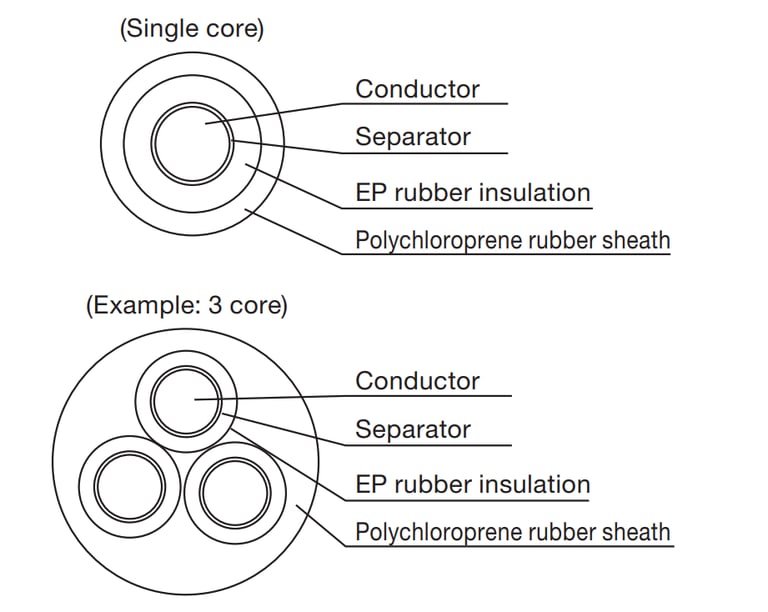Type 2PNCT (2TC Light) Reeling Rubber Cable: The Backbone of Industrial Flexibility
Introduction: Powering Dynamic Industrial Applications
Type 2PNCT (2TC Light) Reeling Rubber Cable: The Backbone of Industrial Flexibility
Introduction: Powering Dynamic Industrial
Applications
In the demanding world of industrial machinery, where movement meets power requirements, the 600V Type 2PNCT Reeling Rubber Cable stands as an unsung hero. Often overshadowed by the equipment it powers, this specialized cable plays a crucial role in ensuring continuous operation across various dynamic industrial settings. Whether it's powering a massive crane swinging across a shipyard or enabling the precise movements of automated manufacturing systems, the reliability of these flexible power conduits directly impacts operational efficiency and safety.
The modern industrial landscape demands cables that can withstand constant motion, environmental challenges, and mechanical stress while maintaining consistent electrical performance. The 2PNCT cable, with its unique construction and materials, represents the culmination of engineering efforts to meet these demanding requirements. As industries evolve toward more automated and flexible operations, understanding the technical intricacies of these specialized cables becomes increasingly important for engineers, maintenance professionals, and facility managers alike.
This article delves into the technical specifications, construction details, and practical applications of the 600V Type 2PNCT Reeling Rubber Cable, providing valuable insights for those involved in the selection, installation, and maintenance of industrial power systems.
The Engineering Marvel: Understanding 2PNCT Cable Construction
Conductor: The Path of Power
At the heart of every 2PNCT cable lies its conductor system. Unlike standard cables, 2PNCT cables feature either tinned annealed copper or stainless steel wire conductors specifically engineered for flexibility and durability. These conductors are typically constructed in a stranded format, with numerous thin wires bundled together rather than a single solid core. This design enables the cable to flex repeatedly without fatigue or breakage—a critical feature for reeling applications.
The tinning process, where a thin layer of tin is applied to the copper strands, serves multiple purposes: it improves solderability, prevents oxidation, and enhances the conductor's resistance to corrosive environments. In more specialized applications where extreme corrosion resistance is required, stainless steel conductors may be utilized, though with some sacrifice to electrical conductivity.
Insulation: Protection from Within
Surrounding each conductor is a layer of Ethylene Propylene Rubber (EPR) insulation. EPR represents a significant advancement over traditional PVC insulation, particularly for cables subject to continuous movement and environmental stress. The molecular structure of EPR provides exceptional electrical properties, maintaining stable dielectric strength even as the cable ages and experiences thermal cycling.
Some key benefits of EPR insulation in 2PNCT cables include:
Excellent thermal stability, allowing operation at temperatures ranging from -15°C to +80°C
Superior electrical resistance, minimizing leakage current between conductors
Remarkable resilience to ozone exposure, a common issue in industrial environments with high-voltage equipment
Enhanced resistance to water absorption, which helps maintain electrical properties even in humid conditions
The insulation layer is precisely calibrated in thickness according to the cable's voltage rating and conductor size, ensuring optimal balance between flexibility and protection.
Sheath: The Front Line of Defense
The outer sheath of 2PNCT cables consists of specially formulated chloroprene rubber (CR), commonly known as neoprene. This robust exterior serves as the cable's first line of defense against physical damage and environmental factors. The chloroprene rubber composition provides a remarkable combination of properties that make it ideal for industrial applications:
Outstanding resistance to oils, chemicals, and industrial solvents
Excellent abrasion resistance, crucial for cables that regularly contact machinery or surfaces
Impressive weather resistance, including UV stability for outdoor installations
Self-extinguishing properties that enhance safety in case of fire
Sufficient elasticity to withstand repeated bending without cracking
The sheath thickness is carefully engineered to provide mechanical protection without compromising the cable's flexibility—a delicate balance that distinguishes high-quality 2PNCT cables from inferior alternatives.
Core Identification: Color-Coded for Clarity
To facilitate installation and maintenance, 2PNCT cables employ a standardized color-coding system for core identification. While specific color schemes may vary slightly between manufacturers, most adhere to recognizable patterns:
Two-core cables: black and white
Three-core cables: black, white, and red
Four-core cables: black, white, red, and green
For cables with more than four cores, additional colors or numerical markings may be used. This systematic approach to core identification significantly reduces the risk of connection errors during installation and simplifies troubleshooting when maintenance is required.
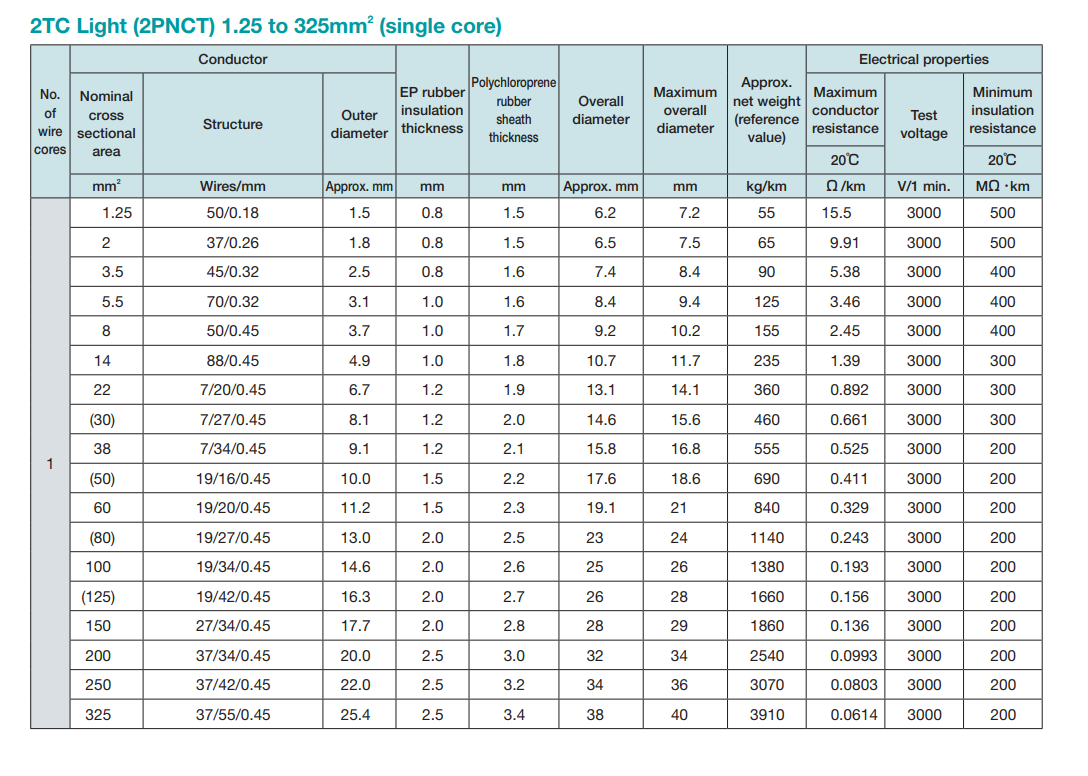

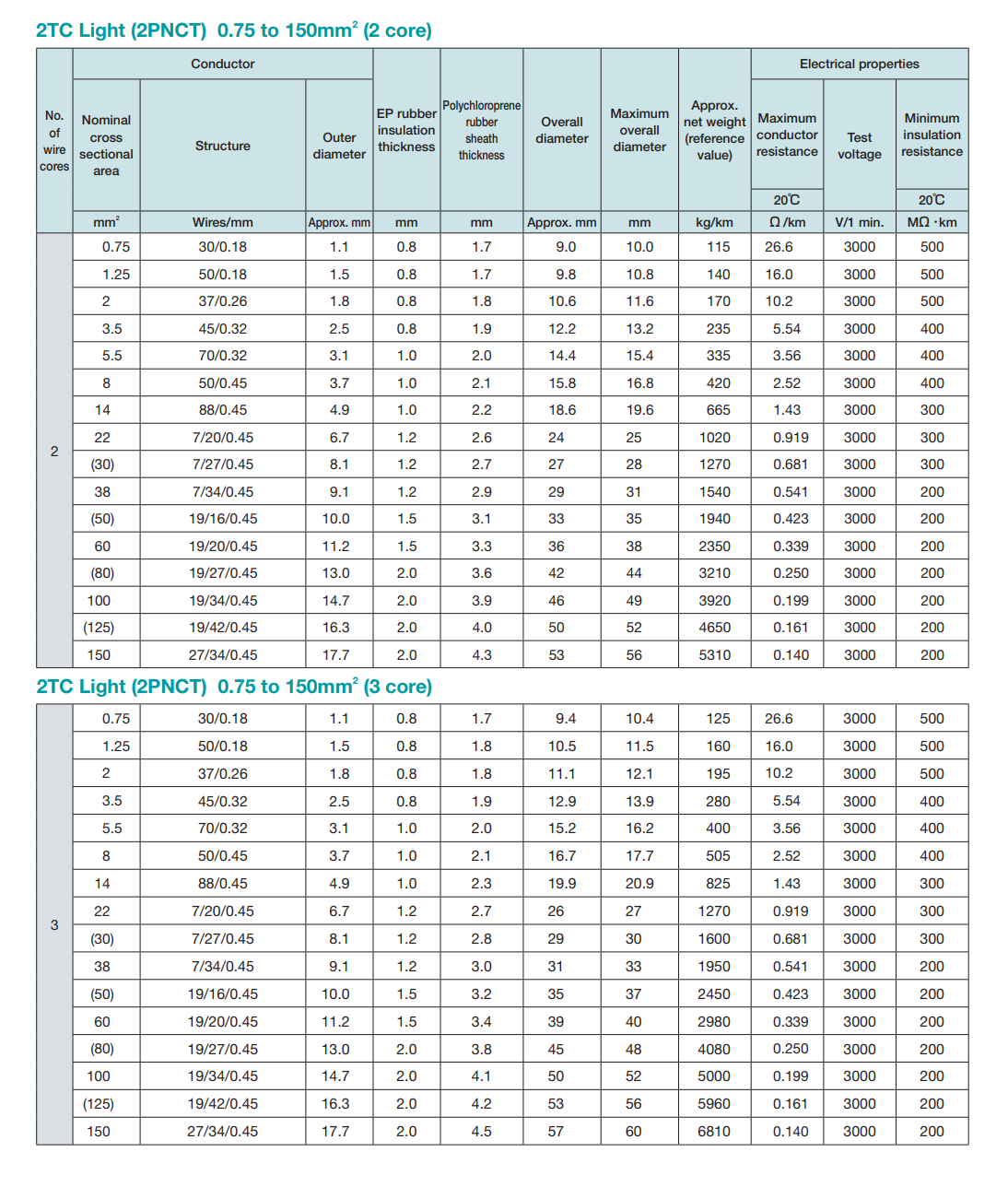

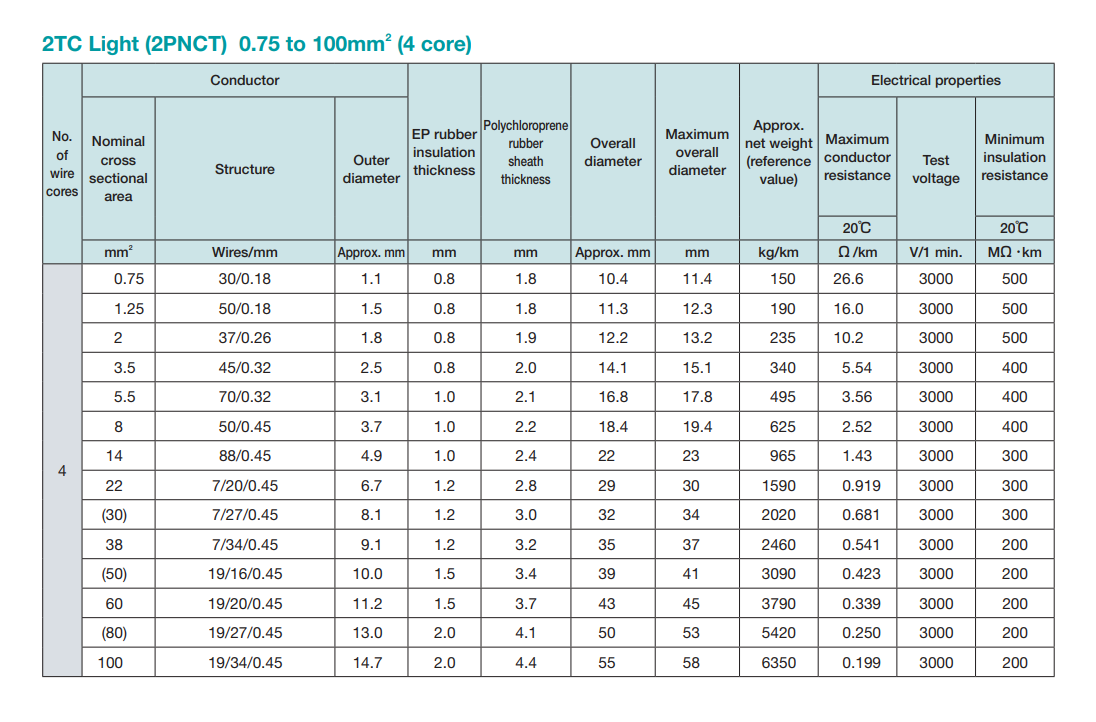


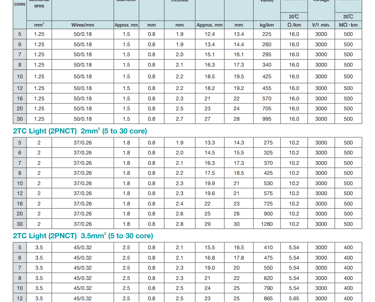
Technical Specifications: Understanding the Numbers
Electrical Characteristics
The electrical properties of 2PNCT cables define their capacity and performance limits:
Rated Voltage: 600V (phase-to-phase), making them suitable for standard industrial power distribution
Test Voltage: Typically 3000V for one minute, ensuring a substantial safety margin
Maximum Conductor Resistance: Varies according to conductor size and ranges from approximately 1.46 Ω/km for larger conductors (14 mm²) to higher values for smaller sizes
Insulation Resistance: Minimum 1000 MΩ·km at 20°C, ensuring minimal leakage current
These electrical specifications must be carefully considered when selecting 2PNCT cables for specific applications, as exceeding these parameters could lead to premature failure or safety hazards.
Thermal Properties
The temperature range for reliable operation stands as a critical factor in cable selection:
Operating Temperature Range: -15°C to +80°C under normal conditions
Maximum Short-Circuit Temperature: 200°C (not to exceed 5 seconds)
Thermal Resistivity: Approximately 3.5 K·m/W, indicating how effectively the cable dissipates heat
These thermal characteristics allow 2PNCT cables to perform reliably in varied industrial environments, from refrigerated warehouses to hot manufacturing floors.
Mechanical Properties
The mechanical resilience of 2PNCT cables determines their suitability for dynamic applications:
Minimum Bending Radius: 7.5 times the overall cable diameter for continuous flexing applications
Maximum Lateral Pressure: Up to 4900 N/m, though this varies based on cable diameter
Tensile Strength: Typically designed to withstand forces of up to 15 N/mm² of conductor cross-section
These mechanical specifications form the foundation for proper installation guidelines, ensuring the cable performs as intended throughout its service life.
Physical Dimensions
2PNCT cables are available in various configurations to meet different application requirements:
Core Counts: Available in configurations ranging from 2 to 49 cores
Cross-Sectional Areas: Commonly available from 1.25 mm² to 100 mm²
Overall Diameter: Varies based on core count and cross-sectional area, typically ranging from 8 mm to 50 mm
Weight: Ranges from approximately 100 kg/km for smaller cables to over 5000 kg/km for larger variants
The selection of appropriate physical dimensions directly impacts installation feasibility, cable management systems, and the overall performance of the reeling system.
Applications: Where 2PNCT Cables Excel
Reeling Systems
The primary application for 2PNCT cables is in reeling systems, where cables must withstand repeated winding and unwinding operations. These systems are common in:
Port cranes and container handling equipment
Mobile mining machinery
Stacker-reclaimers in bulk material handling
Automated storage and retrieval systems (AS/RS)
In these applications, the cable undergoes thousands of flexing cycles while transmitting power reliably to moving equipment. The combination of flexible conductors, resilient insulation, and durable outer sheath makes 2PNCT cables particularly well-suited for these demanding scenarios.
Festoon Systems
In festoon applications, cables are suspended in loops from trolleys or carriages that move along a track. The cable must repeatedly form and reform these loops without developing kinks or experiencing insulation fatigue. Common festoon applications include:
Bridge cranes in manufacturing facilities
Transfer cars in automotive assembly lines
Automated guided vehicle (AGV) charging systems
Linear transport systems in logistics centers
The excellent flexibility and durability of 2PNCT cables make them ideal for these scenarios, where the cable's ability to maintain its electrical and mechanical integrity despite constant movement is paramount.
Carrier Drum Systems
Carrier drum systems represent another challenging application where 2PNCT cables demonstrate their value. In these systems, the cable winds and unwinds from a motorized drum as equipment moves along a fixed path. Examples include:
Long-travel gantry cranes
Longitudinal conveyors in mining operations
Straddle carriers in intermodal terminals
Rubber-tired gantry (RTG) cranes in container yards
The combination of abrasion resistance and flexibility makes 2PNCT cables particularly well-suited for carrier drum applications, where the cable experiences both bending stress and surface contact with the drum.
Vertical Reeling Systems
Perhaps the most demanding application for power cables is vertical reeling, where the cable must support its own weight while flexing. Found in:
Mine hoists and elevators
Deep well pumping systems
High-rise construction equipment
Landfill applications where cables extend down slopes
In these scenarios, the tensile strength of the cable becomes especially important, as does its ability to maintain electrical performance despite the mechanical stress of supporting its own weight over significant distances.
The 2PNCT Advantage: Why These Cables Stand Out
Unparalleled Flexibility
The defining characteristic of 2PNCT cables is their exceptional flexibility. Engineered specifically for applications requiring continuous movement, these cables can withstand thousands of bending cycles without developing the fatigue cracks that plague less specialized cables. This flexibility stems from:
The finely stranded conductor construction
The inherent elasticity of the EPR insulation
The carefully formulated chloroprene rubber sheath
Optimized internal structure that allows movement without internal abrasion
For operations dependent on moving machinery, this flexibility translates directly into extended service life and reduced maintenance costs.
Extraordinary Durability
Industrial environments present numerous challenges to cable integrity, from chemical exposure to mechanical stress. 2PNCT cables excel in these harsh conditions due to:
Resistance to a wide range of industrial oils and chemicals
Superior abrasion resistance compared to PVC-jacketed alternatives
Excellent resistance to tearing and cutting
Ability to withstand repeated compression and tension cycles
This durability ensures that 2PNCT cables continue performing reliably long after conventional cables would require replacement, making them a cost-effective choice despite their higher initial investment.
Environmental Resilience
Modern industrial operations often expose cables to extreme environmental conditions. 2PNCT cables maintain their performance despite:
Exposure to UV radiation in outdoor installations
Contact with ozone, often present around high-voltage equipment
Temperature fluctuations across a wide operating range
Humidity and moisture in various industrial settings
This environmental resilience makes 2PNCT cables suitable for diverse applications across multiple industries and geographic locations.
Standards Compliance
Quality 2PNCT cables adhere to rigorous international standards, ensuring consistent performance and safety:
Compliance with JIS C 3327 (Japanese Industrial Standard)
Adherence to IEC standards for flexible cables
Conformity with regional safety requirements
Compatibility with industry-specific standards for particular applications
This standards compliance provides assurance that the cable will perform as expected and integrate seamlessly with other components in industrial power systems.
Installation and Maintenance: Maximizing Cable Lifespan
Pre-Installation Considerations
Proper cable selection and preparation are essential prerequisites for successful installation:
Verify that the cable's specifications match the application requirements
Calculate the required length, accounting for movement patterns and safety margins
Inspect the cable for any shipping damage before installation
Store the cable on appropriate reels at temperatures between 5°C and 40°C until installation
These preparatory steps help ensure that the cable arrives at the installation site in optimal condition and meets the specific needs of the application.
Installation Best Practices
The installation process significantly impacts cable performance and longevity:
Maintain the minimum bending radius at all times during installation
Ensure proper tension control to prevent excessive stretching
Install appropriate support and guidance systems to minimize mechanical stress
Allow sufficient acclimatization time if the cable has been stored in significantly different temperature conditions
For reeling applications specifically, ensure that the cable tracks properly on the reel and that any guiding systems align correctly to prevent binding or excessive wear.
Ongoing Maintenance
Regular inspection and maintenance are crucial for maximizing cable service life:
Establish a schedule for visual inspections, looking for signs of abrasion, cuts, or deformation
Clean the cable periodically to remove accumulated dirt or chemicals that could degrade the sheath
Check attachment points and terminations for signs of strain or movement
Inspect the reeling or festoon system for proper operation and alignment
Detecting and addressing minor issues early can prevent catastrophic failures and extend the operational life of the cable significantly.
Troubleshooting Common Issues
Despite their durability, 2PNCT cables may occasionally exhibit problems that require attention:
Sheath abrasion: Often indicates improper guidance or contact with sharp edges
Kinking: Usually results from exceeding the minimum bending radius or improper reel design
Conductor breakage: May occur due to excessive tension or repetitive stress beyond design limits
Insulation breakdown: Potentially caused by voltage spikes or exposure to incompatible chemicals
Understanding these potential issues and their causes enables prompt, effective remediation before a minor problem escalates into system failure.
Comparative Analysis: 2PNCT vs. Alternative Cable Types
2PNCT vs. 3PNCT
While similar in many respects, 2PNCT and 3PNCT cables differ in several key aspects:
3PNCT cables typically feature a central reinforcing element for additional tensile strength
2PNCT cables generally offer greater flexibility due to their simpler internal structure
3PNCT cables may provide better performance in applications with significant vertical suspension
2PNCT cables often prove more economical for horizontal reeling applications
The choice between these cable types depends primarily on the specific mechanical stresses present in the intended application.
2PNCT vs. VCT Cables
VCT (Vinyl Cabtire) cables represent a common alternative to 2PNCT, with important differences:
VCT cables use PVC insulation and jackets instead of EPR and chloroprene
2PNCT cables offer superior flexibility and fatigue resistance
VCT cables typically cost less initially but may have shorter service lives in dynamic applications
2PNCT cables provide better performance at temperature extremes
For static installations or applications with minimal movement, VCT cables may suffice. However, for true reeling applications, 2PNCT cables provide superior performance and longevity.
2PNCT vs. FFCT Cables
FFCT (Flame-Retardant Flexible Cabtire) cables prioritize fire safety:
FFCT cables feature enhanced flame retardancy compared to standard 2PNCT
2PNCT cables typically offer better mechanical performance in dynamic applications
FFCT cables may be required in environments with stringent fire safety regulations
2PNCT cables generally provide better resistance to oils and chemicals
The selection between these options often comes down to the primary risk factors in the specific installation environment and the relevant safety regulations.
Conclusion: Investing in Reliability
The 600V Type 2PNCT Reeling Rubber Cable represents specialized engineering focused on solving the unique challenges of power transmission in dynamic industrial applications. From its flexible stranded conductors to its resilient chloroprene sheath, every aspect of its design contributes to exceptional performance in environments where lesser cables would quickly fail.
While the initial investment in quality 2PNCT cables may exceed that of general-purpose alternatives, the return on investment becomes clear when considering the total cost of ownership. Reduced downtime, fewer replacement cycles, and enhanced system reliability translate directly to operational efficiency and cost savings over the life of the installation.
For engineers and maintenance professionals tasked with ensuring reliable power transmission to moving equipment, understanding the technical characteristics and proper application of 2PNCT cables is essential knowledge. By selecting appropriate cables and following best practices for installation and maintenance, these professionals can significantly enhance the reliability and longevity of critical industrial systems.
Whether powering a massive port crane or enabling the precise movements of factory automation, the humble 2PNCT cable continues to play a vital role in modern industrial operations—a testament to the importance of specialized engineering in even the most seemingly mundane components.
Frequently Asked Questions (FAQs)
What makes 2PNCT cables different from standard rubber cables?
The primary distinction lies in the specialized construction designed specifically for reeling applications. Unlike standard rubber cables, 2PNCT cables feature highly flexible stranded conductors, EPR insulation with superior thermal properties, and a chloroprene rubber sheath engineered to withstand thousands of bending cycles. The internal structure is also optimized to minimize internal friction during flexing, significantly extending service life in dynamic applications.
Can 2PNCT cables be installed outdoors?
Yes, 2PNCT cables are well-suited for outdoor installations due to their weather-resistant chloroprene rubber sheath. This material provides excellent protection against UV radiation, ozone, and moisture, allowing the cable to maintain its electrical and mechanical properties despite exposure to the elements. However, for extremely harsh environments or direct burial applications, additional protection may be advisable.
What is the expected lifespan of a 2PNCT cable in continuous reeling operation?
Under proper installation conditions and with appropriate maintenance, quality 2PNCT cables can withstand 1-3 million bending cycles, translating to approximately 5-10 years of service in typical reeling applications. However, actual lifespan varies significantly based on factors such as bending radius, operating temperature, cycle frequency, and mechanical stress. Regular inspection and appropriate maintenance can substantially extend this service life.
Are custom configurations available for specific industrial requirements?
Yes, many manufacturers offer customized 2PNCT cables to meet specific application needs. Common customizations include special conductor sizes, hybrid configurations combining power and control conductors, enhanced shielding for environments with high electromagnetic interference, armored variants for extreme mechanical protection, and custom color coding for specialized installations. These customized solutions typically require minimum order quantities and longer lead times.


Frequently Asked Questions (FAQ)
What is a 2PNCT cable?
A 2PNCT cable is a flexible rubber-insulated and sheathed power cable designed for dynamic applications requiring frequent bending and movement, such as in reeling systems.
What does "2PNCT" stand for?
"2PNCT" refers to a specific type of rubber cabtyre cable with enhanced flexibility and durability, suitable for industrial applications involving movement.
What is the voltage rating of 2PNCT cables?
2PNCT cables are rated for 600V AC, making them suitable for standard industrial power distribution systems.
What materials are used in 2PNCT cable construction?
They typically feature tinned annealed copper or stainless steel conductors, EPR (Ethylene Propylene Rubber) insulation, and a chloroprene rubber (neoprene) outer sheath.
What are the key features of EPR insulation?
EPR insulation offers excellent thermal stability, electrical resistance, and resilience to environmental factors like ozone and moisture.
Why is chloroprene rubber used for the outer sheath?
Chloroprene rubber provides superior resistance to oils, chemicals, abrasion, and weather conditions, enhancing the cable's durability.
What applications are 2PNCT cables suitable for?
They are ideal for reeling systems, festoon systems, carrier drum systems, and vertical reeling systems in industries like mining, construction, and manufacturing.
Can 2PNCT cables be used outdoors?
Yes, their robust construction makes them suitable for outdoor applications, withstanding UV exposure and varying weather conditions.
What is the temperature range for 2PNCT cables?
They operate effectively between -15°C and +80°C, with a maximum short-circuit temperature of 200°C for up to 5 seconds.
What is the minimum bending radius for 2PNCT cables?
The minimum bending radius is typically 7.5 times the overall cable diameter, ensuring flexibility without compromising integrity.
Are 2PNCT cables flame-retardant?
Yes, the chloroprene rubber sheath has self-extinguishing properties, enhancing fire safety.
How is core identification managed in 2PNCT cables?
Cores are color-coded: black and white for two-core cables; black, white, and red for three-core; and additional colors for more cores.
What standards do 2PNCT cables comply with?
They adhere to standards like JIS C 3327 and relevant IEC standards, ensuring quality and safety.
What is the typical lifespan of a 2PNCT cable?
With proper installation and maintenance, they can last 5–10 years, depending on usage conditions.
Can 2PNCT cables be customized?
Yes, manufacturers can customize aspects like core count, conductor size, and sheath color to meet specific requirements.
What is the maximum conductor resistance in 2PNCT cables?
It varies by conductor size; for example, a 14 mm² conductor has a maximum resistance of approximately 1.46 Ω/km.
Are there multi-core versions of 2PNCT cables?
Yes, configurations range from 2 to 49 cores, accommodating various application needs.
What is the significance of tinned copper conductors?
Tinning enhances corrosion resistance and solderability, extending the conductor's lifespan.
How does 2PNCT compare to VCT cables?
2PNCT cables offer superior flexibility, durability, and environmental resistance compared to standard VCT cables.
What maintenance is required for 2PNCT cables?
Regular inspections for wear, cleaning, and ensuring proper tension and alignment in reeling systems are recommended.
Can 2PNCT cables handle vertical reeling applications?
Yes, their tensile strength and flexibility make them suitable for vertical reeling in applications like mine hoists.
Are 2PNCT cables resistant to oils and chemicals?
The chloroprene sheath provides excellent resistance to various oils and industrial chemicals.
What is the test voltage for 2PNCT cables?
They are typically tested at 3000V AC for one minute to ensure insulation integrity.
How do 2PNCT cables perform in humid environments?
EPR insulation and the sealed sheath design minimize moisture ingress, maintaining performance in humid conditions.
What is the maximum permissible tensile force for 2PNCT cables?
It depends on the conductor size; for instance, a 3x14 mm² cable has a maximum tensile force of 1.7 kN.
Can 2PNCT cables be used in festoon systems?
Yes, their flexibility and durability make them ideal for festoon applications in cranes and similar equipment.
What are the color options for 2PNCT cable sheaths?
Black is standard, but other colors may be available upon request to suit specific applications.
Do 2PNCT cables support signal transmission?
While primarily for power, some configurations may include signal cores; consult the manufacturer for options.
Are there armored versions of 2PNCT cables?
Yes, armored variants are available for applications requiring additional mechanical protection.
What is the weight range of 2PNCT cables?
Weights vary by size and core count, ranging from approximately 100 kg/km to over 5000 kg/km.
Can 2PNCT cables be used in mining operations?
Yes, their rugged construction makes them suitable for the demanding conditions of mining environments.
What is the maximum lateral pressure 2PNCT cables can withstand?
They can handle lateral pressures up to 4900 N/m, depending on the specific cable design.
Are 2PNCT cables UV-resistant?
Yes, the chloroprene sheath offers good resistance to UV radiation, suitable for outdoor use.
What is the insulation resistance of 2PNCT cables?
Typically, they have a minimum insulation resistance of 1000 MΩ·km at 20°C.
Where can I purchase 2PNCT cables?
Feichun Cable offers a range of 2PNCT cables. Contact our sales team for product information and purchasing options.
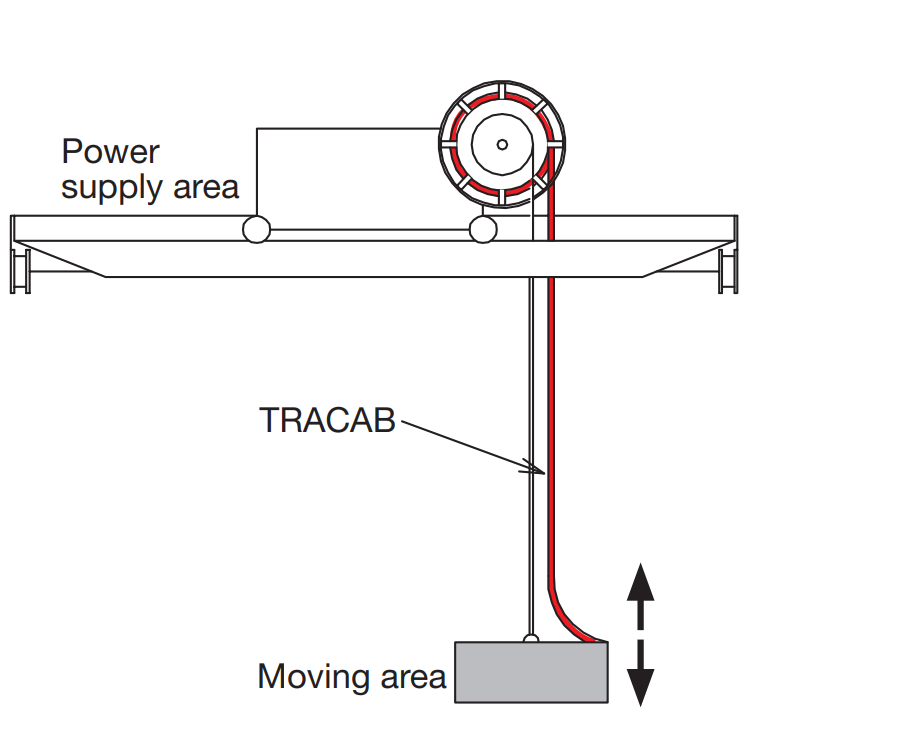

Type 2PNCT (2TC Light) Reeling Rubber Cable: The Backbone of Industrial Flexibility
Discover the technical excellence of 600V Type 2PNCT Reeling Rubber Cables. Engineered for durability and flexibility, these cables are ideal for dynamic industrial applications, ensuring reliable power delivery in challenging environments.
5/1/202514 min read

